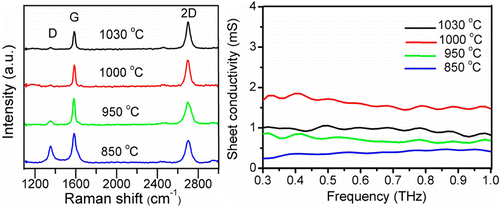† State Key Lab Incubation Base of Photoelectric Technology and Functional Materials, International Collaborative Center on Photoelectric Technology and Nano Functional Materials, Institute of Photonics & Photon-Technology, Northwest University, Xi’an 710069, China
‡ School of Electronic Engineering and Automation,Guilin University of Electronic Technology, Guilin 541004, China
J. Phys. Chem. C, Article ASAP
DOI: 10.1021/jp502260k
Publication Date (Web): June 17, 2014
Copyright © 2014 American Chemical Society
*Tel.: +86-29-88303336. Fax: +86-29-88303336. E-mail: xlxuphy@nwu.edu.cn., *Tel.: +86-29-88303336. Fax:+86-29-88303336. E-mail: rzy@nwu.edu.cn.
Graphene has shown great potential for terahertz (THz) applications in recent years. THz sheet conductivity of graphene is essential to assess the high performance of THz devices such as modulators based on graphene. In this work, THz sheet conductivity of graphene grown with different temperatures, along with the effects of chemical doping by HNO3, were studied in detail. Graphene films were synthesized on Cu surface by atmospheric pressure chemical vapor deposition with C2H2. Different samples with growth temperature from 850 to 1030 °C were characterized by Raman spectroscopy, transmission electron microscope, and UV–vis spectroscopy. THz time-domain spectroscopy was used to study the THz sheet conductivity of the samples before and after HNO3 doping. The results show that graphene grown at 1000 °C has the highest THz sheet conductivity. As compared to the sample grown at 850 °C, the value enhances 600%. In addition, after HNO3 doping, the THz sheet conductivity of the sample grown at 1000 °C becomes 2.42 mS, which enhances 44%. These indicate that both the optimization of the growth temperature and chemical doping can improve the THz sheet conductivity of graphene significantly. Combining with the characterization of the material, we have attributed the effect of the growth temperature to the influence of carrier momentum scattering time in graphene, and the chemical doping to the influence of the carrier concentration in graphene. This work advances the understanding of improving THz sheet conductivity by in situ growth and postgrowth and paves the way for efficient THz components with graphene.

No comments:
Post a Comment